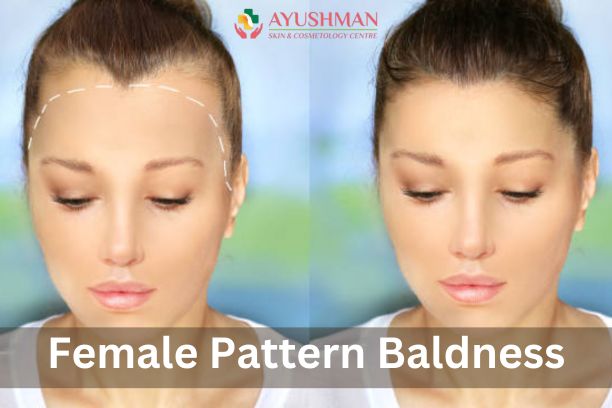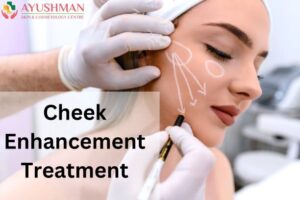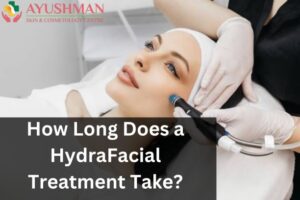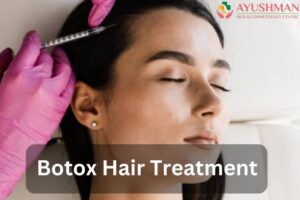Are you currently facing issues with hair thinning or loss? It’s worth considering the possibility of female pattern baldness, scientifically referred to as androgenic alopecia. This widespread condition affects a substantial number of women. This common condition affects millions of women and people assigned female at birth (AFAB).
Take the first step towards regaining your confidence and addressing Female Pattern Baldness. Call us at +91-9599816603/04 to explore personalized treatment options and start your journey to healthier, fuller hair. Don’t wait—take action now for a positive change!
Table of Contents
ToggleWhat Is Female Pattern Baldness?
Female pattern baldness is a gradual thinning of hair on the scalp, primarily affecting the crown and top of the head. Unlike male pattern baldness, which typically causes a receding hairline, female hair loss usually maintains the hairline while causing diffuse thinning.
What Are The Steps In Female Pattern Baldness?
Female pattern baldness has five stages, as per the Sinclair scale:
Stage 1: Minimal or no hair loss.
Stage 2: A small gap shows up in the middle of your hair part.
Stage 3: The gap in your hair part widens, and there is hair loss on both sides.
Stage 4: Bald spots become noticeable near the front of your hairline.
Stage 5: Significant hair loss.
Causes of female pattern baldness?
Female pattern baldness is influenced by various factors, including:
- Age: The likelihood of experiencing female pattern baldness rises with age. About one-third of women and individuals assigned female at birth (AFAB) go through this at some point in their lives. After menopause, approximately two-thirds of women and AFAB individuals may face thinning hair or complete hair loss.
- Hormones: The hormone dihydrotestosterone (DHT), belonging to the androgen group, plays a role. Androgens aid in puberty and physical maturity, including the growth of hair on the face, scalp, chest, underarms, and genitals. Following menopause, hormone levels drop, potentially impacting DHT levels. There’s a suggested connection between DHT and the shrinking of hair follicles.
- Genetics: If your close relatives, like parents or siblings, have a history of hair loss, you’re more likely to experience female pattern baldness.
Other Causes Of Hair Loss
While female pattern baldness is often linked to genetics, it can also result from an underlying issue affecting the production of the hormone androgen.
Androgen, a hormone tied to pattern baldness, may be influenced by conditions like tumors in the pituitary gland or ovary, which release androgen and could contribute to hair loss.
Other causes of hair loss in women encompass:
- Autoimmune disease: Alopecia areata, an uncommon autoimmune disorder, prompts the immune system to attack hair follicles, leading to hair loss.
- Medication: Some drugs, especially those used for cancer treatment, may cause hair loss as a side effect. Generally, hair tends to grow back once the medication is discontinued.
- Illness: Significant illnesses, such as severe infections, high fevers, or surgeries, can trigger hair loss.
- Traction alopecia: This is hair loss resulting from frequently wearing hairstyles that excessively tug at the hair.
Treatment Options For Female Hair Baldness
In female pattern baldness, hair loss can be permanent if left untreated, but most cases involve mild to moderate hair loss, and treatment is not necessary if you’re comfortable with your appearance.
Medicines:
The only FDA-approved medication for treating female pattern baldness is minoxidil. It’s applied to the scalp, with the recommended options being a 2% solution or 5% foam for women. Minoxidil may stimulate hair growth in about 1 in 4 or 5 women, slowing or stopping hair loss for many. Consistent, long-term use is essential, as hair loss may resume if the application is stopped, and the newly grown hair might fall out. If minoxidil doesn’t work, your healthcare provider may suggest alternatives like spironolactone, cimetidine, birth control pills, and ketoconazole, among others.
Hair Transplant:
For those not responding well to medical treatment and lacking significant cosmetic improvement, a hair transplant is an option. This involves removing small hair plugs from thicker areas and transplanting them into balding areas. While there may be minor scarring and a slight risk of skin infection, the results are often excellent and permanent. Multiple transplants may be needed, and it can be a costly procedure.
Other Solutions:
Less invasive options like hair weaving, hairpieces, or a change in hairstyle can effectively conceal hair loss and enhance your appearance. This is generally the most affordable and safest approach to address female pattern baldness.
Preventing Female Pattern Baldness
Is it possible to prevent female pattern baldness? Currently, there’s no known method to completely prevent it. However, there are steps you can take to maintain healthy hair and potentially support hair growth:
- Boost Protein Intake: Especially if you’re a vegetarian or vegan, increasing your protein consumption to 40 to 60 grams per day can be beneficial. The Mediterranean diet, which includes fruits, vegetables, and protein, may contribute to minimizing hair loss.
- Take Vitamins: Certain vitamins and minerals such as A, B, C, D, E, zinc, and iron play a role in maintaining healthy hair, skin, and muscle tissue.
- Manage Stress: Finding effective ways to cope with stress is crucial, as stress can potentially trigger female pattern baldness by increasing androgen activity.
While prevention may not be guaranteed, these lifestyle adjustments can contribute to overall hair health. For customized guidance, it’s essential to seek advice from your healthcare provider.
Conclusion
If you’re experiencing hair loss, it’s advisable to consult with a doctor or dermatologist to determine the type and potential causes of your hair loss. Seeking professional advice is crucial for accurate diagnosis and effective treatment.
Choosing Ayushman Skin & Cosmetology Centre for your hair loss is the best choice for exceptional care and results. Where you’ll be attended to by experienced dermatologist Dr. S.P. Singh. We are known for delivering optimal results. Schedule your appointment today. The sooner you seek treatment, the better the chances of halting and potentially regrowing your hair.
FAQ’s
Q: Can genetics cause female pattern baldness?
A: Yes, genetics play a role in female pattern baldness, as it is inherited from biological parents. You are more likely to experience it if your parents or close relatives have also had hair loss.
Q: What else causes female pattern baldness?
A: Female pattern baldness is associated with an underlying hormonal condition or a tumor that secretes hormones. If you notice symptoms like irregular periods, severe acne, or increased unwanted hair, it’s advisable to consult a healthcare professional, as these may indicate a different type of hair loss.
Q: Can people get female pattern baldness in their 20s?
A: It’s less common to develop female pattern baldness in your 20s. This condition is more likely to begin in the 40s, 50s, or later stages of life.
Q: Can female pattern baldness worsen?
A: Yes, female pattern baldness can progress over time without treatment. The progression is usually slow, taking years or even decades to worsen. Periods of stability may be followed by phases of more rapid hair loss, especially if the onset is earlier.
Q: Can you prevent female pattern baldness?
A: Currently, there is no known way to prevent female pattern baldness, but various treatments can help manage and slow down the progression of hair loss.




